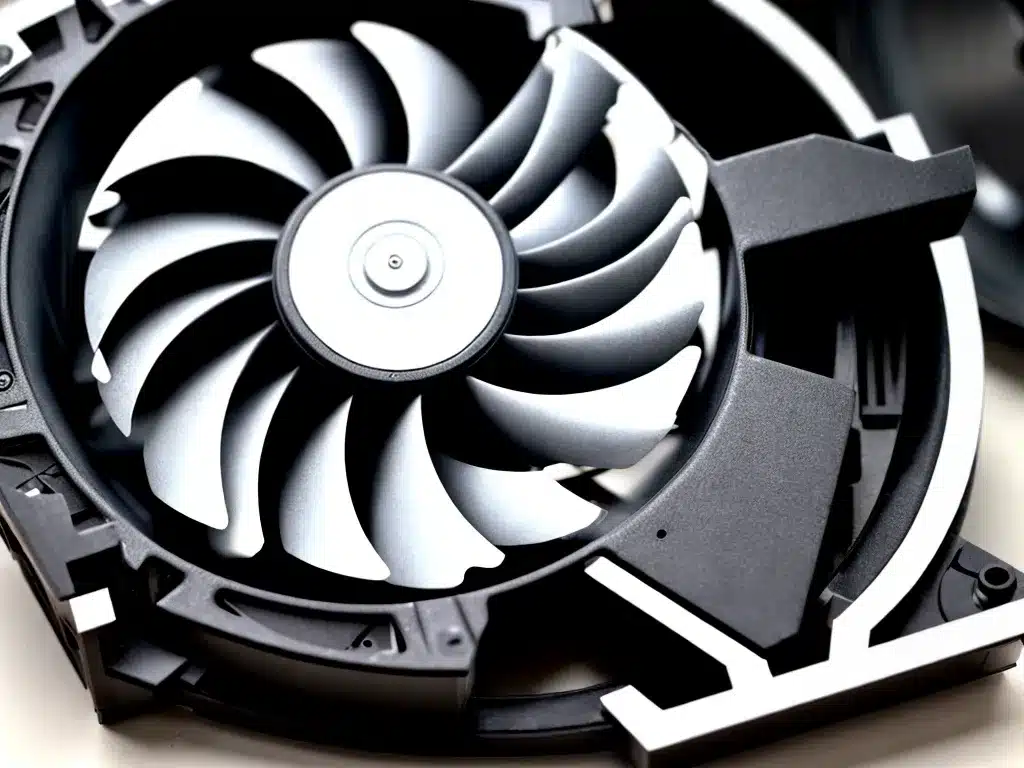
Understanding Fan Noise in Your PC
Computer fans play a critical role in keeping your PC components cool. However, noisy fans can be an annoyance. Fan noise often occurs when the fan bearings start to wear out or when dust/debris accumulates on the fan blades. Troubleshooting and fixing noisy PC fans is a relatively straightforward process that can restore normal quiet operation.
Common Causes of Noisy Fans
There are several common causes of noisy PC fans:
-
Worn fan bearings – Fan bearings operate under a lot of stress over time. Worn bearings can create grinding, rattling noise as the fan spins. This usually indicates the fan needs replacement.
-
Imbalanced blades – If fan blades become bent or damaged, it can create imbalance. This imbalance adds strain on the motor and bearings. Badly imbalanced fans generate noise or even vibration.
-
Dust buildup – Dust accumulation on fan blades disrupts normal airflow. This forces the fan to spin faster, which creates noise. Cleaning the fans alleviates this.
-
Wire obstructions – Wires blocking fan rotation cause strain. Ensure no obstructions are hitting fan blades.
-
Age – Fan motors lose efficiency over time. Older fans tend to generate more noise due to wearing out.
Main Fan Types in PCs
There are a few main fan types found inside PCs:
-
CPU cooler fans – These fans sit atop CPU coolers and keep the CPU from overheating. High demands on the CPU cause these fans to ramp up speed and get louder. Replacing an old CPU fan or upgrading the cooler often reduces noise.
-
Case fans – Case fans maintain proper airflow through the PC case. Too few case fans forces them to run faster/louder. Adding more case fans reduces individual fan speed.
-
Power supply unit (PSU) fan – The PSU has an internal fan that cools the power supply. PSU fans use sleeve/rifle bearings and tend to wear out over ~3 years. Replacing an aging PSU reduces noise.
-
Graphics cards fans – GPUs contain multiple fans to cool the graphics card heatsink/PCB. Faulty GPU fans are replaced by installing custom or OEM replacement fans.
Troubleshooting Noisy Case and CPU Fans
Pinpointing the exact fan making noise is the first step. From there, you can troubleshoot the root cause and best solution.
Isolating the Noisy Fan
Follow these tips to isolate noisy case or CPU cooler fans in a PC:
-
Listen closely – Turn off other nearby devices and listen to the noise pattern. Note if the noise is intermittent or constant.
-
Stop individual fans – Power down the PC, open the case, and prevent each fan from spinning briefly. Determine if noise lessens.
-
** Stress test ** – Run intensive GPU/CPU apps to make fans hit max speed. Identify fans that get louder or rattle when spinning faster.
-
Replace one fan – Swap the suspect fan with a known good, quiet fan. If noise disappears, it points to the original fan.
Diagnosing Fan Noise Issues
Once you’ve identified the culprit, diagnose what is causing the noise by:
-
Inspecting fan – Look for damaged/cracked blades, obstructions in blades, buildup of dirt/dust.
-
Checking bearings – Feel for grinding sensation when spinning fan. Bad bearings are often the issue.
-
Testing voltage – Use a multimeter to test voltage from motherboard header to fan. Low voltage can cause premature failure.
-
Examining wires – Ensure fan wires are not being pinched or pulled in a way that obstructs spinning.
-
Considering fan age – Note how long fan has been in operation. Older fan motors tend to wear out and generate noise.
Resolving Noisy Fan Problems
Once you’ve diagnosed the cause, utilize these tips to fix the noise:
-
Cleaning fans – Use compressed air to blow out dust from fan blades/housing. Avoid spinning fans quickly with air.
-
Straightening bent blades – Carefully bend any warped blades back into shape using pliers or small screwdriver.
-
Lubricating bearings – Put 1-2 drops of sewing machine oil or bearing oil on fan shaft bearing.
-
Checking wires – Make sure no wires are obstructing or rubbing against fan blades.
-
Replacing fan – If bearings are shot or blades damaged, replace old fan with a new equivalent fan.
-
Adding/upgrading fans – Insufficient case fans lead to noisy operation. Adding more case fans or installing better CPU cooler can help.
-
Replacing PSU – If PSU fan is old and noisy, replacing entire PSU may be best option.
-
Adjusting fan curves – Use motherboard software to create more gradual fan speed ramp-up to reduce abrupt noise changes.
Best Practices for Reducing PC Fan Noise
Here are some overall best practices to employ that reduce annoying computer fan noises:
-
Clean PC fans and vents regularly using compressed air to avoid dust buildup.
-
Ensure case has adequate air flow and number of fans. More fans at lower speeds is quieter.
-
Upgrade to CPU cooler and case fans designed for quieter operation. Focus on quality bearings.
-
Ensure sufficient case cooling so components like GPU/CPU don’t get too hot and ramp up internal fans.
-
Isolate PC case from objects that amplify vibration and noise (e.g. wood desks).
-
Use fan speed control software in BIOS or OS to customize optimal fan curves for your setup.
-
Consider a quieter power supply unit if the PSU fan is the culprit. Quality PSU fans last longer.
-
Replace aging case/CPU fans after ~3 years before bearings start to deteriorate and cause noise.
-
Choose fans with rubber vibration dampeners to reduce noise caused by vibration against case.
By methodically troubleshooting noisy computer fans, diagnosing underlying issues, and properly fixing or replacing them, you can eliminate distracting fan noise and maintain a quieter PC. Employing routine maintenance and noise reduction best practices also helps prevent annoying fan noises down the road.












